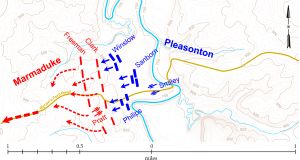Search:
Powered by
Website Baker
Tour Stop, “Philips' Brigade Assaults Bloody Hill”
[Waypoint = 39.015248, -94.527273]
Directions
Walk south through the mowed field until you reach Manchester Trafficway. Cross the street and turn right to head west on Manchester Trafficway. Be careful crossing the railroad tracks. Stop anywhere in the mowed area near the historical marker. .
Description
|
Map of Federal Assault on Bloody Hill by theCivilWarMuse based on USGS 1935 Kansas City Quadrangle (Click map for larger image) |
You are now standing on the edge of the ravine Philips’ Brigade used for cover as they prepared to assault Bloody Hill. After crossing the railroad tracks, you passes in between the rock outcroppings, through which the Byram’s Ford Road ran. But back in 1864 the Byram’s Ford Road passage through the rock outcroppings was much narrower than it is now. The narrow passage made it difficult for Philips to assault the Confederate positions.
The men in Philips’ Brigade had reached this position by crossing over several hundred yards of open ground, all while exposed to heavy small arms and artillery fire. The Confederates held the high ground and were protected behind fence rails, entrenchments, and a few log houses, one of which was about 120 yards west of your current position. They had also posted sharpshooters up in the trees to pick off the Federal officers.
At the previous tour stop we learned about Winslow’s attempt to lead a charge against the Confederates that left Winslow wounded in the leg and out of action. After Winslow fell, the attack stalled and was repulsed. The Federals now realized a mounted charge was not going to work. The Federal cavalrymen were ordered to dismount and make a concerted effort against the hill. Philips led his entire brigade up against the Confederates and succeeded in driving them further up the hill to their last line of defense. This assault occurred at the same time that Lieutenant Colonel Frederick W. Benteen led Winslow’s Brigade on the Federal right against the Confederates on Bloody Hill.
Historical Vignettes
Colonel John F. Philips described the successful attack in his official report.
"My command, then occupying the position from which the enemy had just been driven, began to advance across this field, where ensued one of the fiercest and most sanguinary conflicts of the engagement. The enemy occupied not only the ground but the very tree tops, their sharpshooters having climbed into these, singling out and shooting our officers and men with fearful success, no less than one field officer and seven line officers falling on this ground.
"The persistent bravery of officers and men was here most admirable. Notwithstanding the ammunition of my command began to fail the position gained was held and the advance prosecuted. Re-enforcements were sent from Colonel Winslow's brigade, when the charge was pressed with increased vigor. The timber was gained and the enemy driven in confusion, leaving his dead and wounded and a large number of prisoners in our hands, the large number of these showing the stubbornness with which the enemy resisted and the desperation with which our men fought. My ammunition train was ordered up, and as soon as the boxes were replenished I moved rapidly forward."
Captain Richard J. Hinton, commanding the Second Kansas Colored State Militia in the Army of the Border, described the late morning attack by the Philips’ Brigade.
"The rebel line … occupied a range of low hills, extending through an open field to the left, and along a bluff covered with dense wood on our right. It was strengthened very much by high fences and some log buildings, behind which the rebels were posted.
"The Brigade of Colonel Philips advanced together, supported by part of Colonel Winslow's command … To drive the enemy from his formidable position, became an absolute necessity. A charge was ordered and made. When within one hundred yards of the rebel line, our troops gave way in disorder, unable to stand the terrible fire … Here the officers … rallied their repulsed but not disheartened men, gallantly exposing themselves in this duty to the scathing fire from the fences … Again both brigades charged. The movement was successful, though the enemy's lines were stubbornly held until the troops met, and the contest became a hand to hand one. Across the field, for one hundred and sixty yards, our troops pushed steadily. They literally moved in face of a shower of lead … The movement was pressed with increased vigor, the enemy driven from their shelter, and as they fell back to the timber, were followed and driven still further west in great confusion … They were urged into the open, and with the dismounted men of the veteran brigade, advanced across the open field at the double-quick to the woods beyond. The enemy resisted the advance with great gallantry. We pushed through the timber to the prairie."
